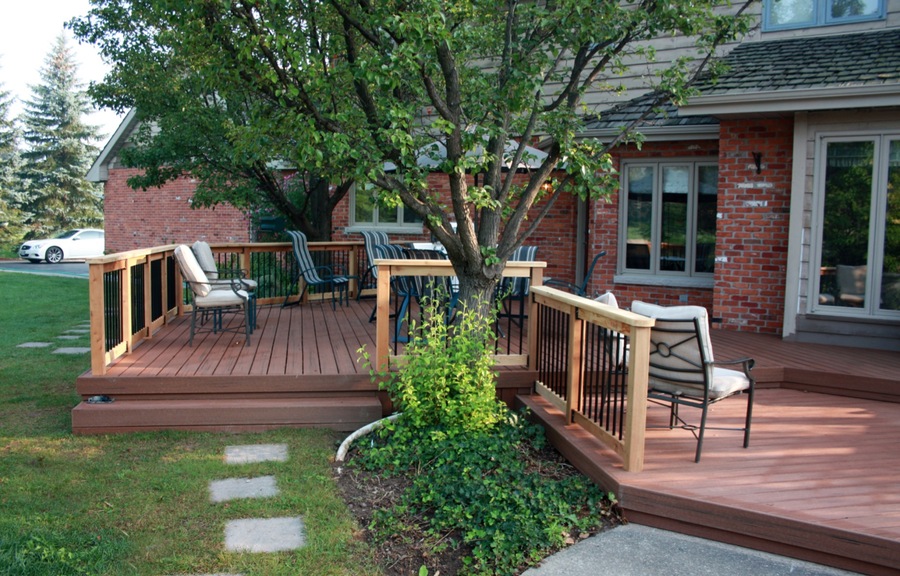Low Patio Deck: Seamless Outdoor Living
A low patio deck is the cornerstone of effortless outdoor living. Positioned close to the ground, these decks merge style with practicality, creating a sleek, modern foundation for relaxation or entertainment. Perfect for flat or slightly sloped yards, low patio decks eliminate the need for cumbersome stairs or railings, making them accessible and visually harmonious with their surroundings.
These low-lying decks can serve as an extension of your indoor space, transitioning seamlessly from the interior to the outdoors. Whether it’s a morning yoga nook or an evening dining spot, low patio decks provide an inviting platform to enjoy life alfresco. Customizable with various materials, finishes, and features, these decks are as versatile as they are visually appealing.
Low Deck Framing: The Skeleton of Stability
When it comes to building a sturdy low deck, the framing is the most critical element. Unlike elevated decks that rely on tall support posts, low deck framing is designed to sit near the ground, requiring unique considerations for moisture resistance, airflow, and leveling.
Key Considerations for Low Deck Framing
- Materials That Last: Opt for pressure-treated wood or composite materials that resist decay, ensuring your deck endures years of exposure to the elements.
- Proper Joist Spacing: Space joists evenly, typically 12 to 16 inches apart, to prevent sagging and ensure even weight distribution.
- Ground Clearance: Maintain at least a few inches of clearance between the deck and the ground to promote airflow and prevent moisture accumulation.
- Support Points: Use concrete pads, pavers, or ground anchors as supports to create a stable base.
Precision is key when framing a low deck. Even slight miscalculations can compromise the structural integrity, making it essential to measure twice and cut once. A well-framed low deck not only ensures safety but also extends the lifespan of the structure.
Low Decks Without Railings: Open and Unrestricted
Low decks without railings are an exercise in simplicity and openness. These designs are perfect for creating a seamless transition between your deck and the surrounding yard, fostering a sense of freedom and flow. By eliminating railings, you also reduce visual barriers, making your outdoor space feel larger and more inviting.
Benefits of Skipping Railings
- Minimalistic Aesthetic: The absence of railings enhances the deck’s clean lines and modern design.
- Cost Savings: Forgoing railings lowers construction costs without sacrificing functionality.
- Accessibility: With no barriers, low decks are ideal for children, pets, and those who prefer step-free transitions.
Creative Alternatives to Railings
- Planters and Greenery: Frame the edges of your deck with tall planters or lush shrubs for a natural boundary.
- Wide Steps: Install broad, gradual steps around the perimeter to create a soft edge.
- Built-In Benches: Incorporate seating along the edges for added functionality while subtly defining the space.
Low decks without railings embody understated elegance, proving that less can indeed be more.
Low-Profile Deck Ideas: Sleek Designs for Modern Living
A low-profile deck is the epitome of functional design. By staying close to the ground, these decks create a subtle yet impactful addition to any outdoor space. Whether you’re looking to enhance your backyard’s usability or add a stylish focal point, low-profile decks offer endless possibilities.
Inspiring Low-Profile Deck Ideas
- Floating Decks: Achieve a contemporary look with hidden supports that make the deck appear as if it’s hovering just above the ground.
- Zoned Spaces: Divide the deck into distinct areas for lounging, dining, or cooking using different materials or layouts.
- Integrated Lighting: Add LED strips along the edges or beneath the deck for a dramatic nighttime effect.
- Natural Finishes: Choose untreated wood or composite materials in earthy tones to complement the surrounding landscape.
- Water Features: Incorporate a small fountain or reflecting pool next to the deck to create a tranquil ambiance.
Low-profile decks blend seamlessly into their surroundings, providing a sleek, modern foundation for your outdoor adventures.
Low Deck Ideas: Creativity Meets Functionality
If you’re considering a low deck for your yard, the design options are limitless. From rustic charm to sleek modernity, these decks can be tailored to fit your personal style and outdoor needs.
Popular Features for Low Decks
- Shade Structures: Add a pergola or retractable awning for comfort on sunny days.
- Outdoor Rugs: Use weatherproof rugs to define different zones and add a pop of color.
- Deck Skirting: Hide the understructure with decorative panels, wood lattice, or greenery for a polished finish.
- Fire Pits: Install a recessed or portable fire pit for cozy gatherings year-round.
- Portable Furniture: Choose lightweight, versatile furniture that can be rearranged to suit different occasions.
Low deck ideas are as varied as the homeowners who design them. Whether you prefer a minimalist look or a deck bursting with personality, there’s no limit to what you can create.
Low-Level Deck Ideas: Optimizing Compact Spaces
Low-level decks are perfect for maximizing functionality in smaller yards or tight spaces. These compact designs pack a lot of charm and utility into a small footprint, proving that you don’t need a sprawling backyard to enjoy outdoor living.
Tips for Small Low-Level Decks
- Vertical Elements: Add trellises or vertical gardens to save space while enhancing visual interest.
- Dual-Function Features: Use built-in benches with storage underneath to make the most of limited square footage.
- Keep It Minimal: Opt for clean lines and minimal décor to avoid overwhelming the space.
- Color Coordination: Use light, neutral colors to make the deck appear larger and brighter.
Low-level decks transform even the smallest yards into functional and stylish retreats, offering big impact in a compact package.
Low-Profile Deck vs. Traditional Elevated Deck
Construction Cost
- Low-Profile Decks: Easier and cheaper to build due to reduced materials and simpler construction methods.
- Traditional Elevated Decks: Require more materials, including posts, railings, and stairs, increasing costs.
Maintenance
- Low-Profile Decks: Minimal maintenance needs due to their close-to-ground design.
- Traditional Elevated Decks: Require ongoing care for railings, supports, and exposed structural components.
Design Flexibility
- Low-Profile Decks: Blend seamlessly with landscapes, making them ideal for subtle, elegant designs.
- Traditional Elevated Decks: Offer dramatic views and are suitable for sloped or uneven terrain.
Safety Features
- Low-Profile Decks: Safer for families with children and pets, as they are closer to the ground.
- Traditional Elevated Decks: Require railings and additional safety measures to prevent falls.
Choosing between the two depends on your yard’s layout, budget, and desired aesthetic.
Frequently Asked Questions
What is considered a low deck?
A low deck is a structure built close to the ground, typically 12 to 24 inches above the surface. These decks don’t require railings or stairs, making them ideal for flat yards or minimalist designs.
Which is cheaper: a deck or a patio?
Patios are generally cheaper because they involve less labor and fewer materials. However, low decks offer more flexibility in design and can be built to match a variety of styles and purposes.
Is a ground-level deck a good idea?
Yes, ground-level decks are an excellent choice for those seeking a cost-effective, low-maintenance outdoor space. They’re perfect for flat terrains and create a seamless transition from your home to your yard.
What are the disadvantages of a floating deck?
Floating decks are easy to install but may lack the stability of anchored decks, especially in areas with heavy rainfall or unstable soil. Regular checks and maintenance are necessary to ensure they remain level and secure.
How do you lay low decking?
To lay low decking:
- Clear and level the ground.
- Install ground anchors or concrete pads for support.
- Build the frame using pressure-treated wood or composite materials.
- Lay decking boards with proper spacing for drainage and airflow.
What is a floating deck?
A floating deck is a freestanding structure that isn’t attached to a house or anchored deeply into the ground. It’s ideal for flat areas and offers flexibility in placement.
What is the cheapest way to build a deck on a budget?
To build a budget-friendly deck:
- Use pressure-treated or reclaimed wood.
- Opt for a simple, low-profile design.
- DIY the construction to save on labor costs.
- Replace concrete footings with gravel or pavers for support.

